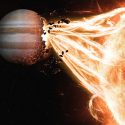The Sun is Yellow
If you’ve always thought our star was a bright yellow ball of fire, you were wrong. For starters, it’s not yellow. It’s green. Sort of. Scientists determine the temperature of a star by the color spectrum it emits. Each color has its own wavelength, and astronomers measure those wavelengths to tell how hot a star is. Cooler stars appear red. The hottest of the stars look blue.
Our Sun emits most of its energy at a wavelength that’s close to green. But because it also emits other wavelengths, all these colors mix together, and your eyes see this vibrant mixture as white. That is, if you look at the Sun from the International Space Station. From here on Earth, the Sun looks yellow because our atmosphere is really good at scattering blue light. With all that blue wavelength gone, all the other colors combine into yellow. If our star was actually yellow, it would be about 800 °C (1400 °F) cooler, our Solar System’s habitable zone would shrink and Earth would become a frozen, lifeless rock. But that’s not the only thing you were wrong about.
The Sun is on Fire
The Sun is hot, but it’s not on fire. Burning is a chemical reaction of oxygen with fuel. Like most stars out there, our Sun is a ball of gas mostly made up of hydrogen and helium. It doesn’t have much oxygen in it. Instead, it works more like a gigantic nuclear reactor, constantly fusing hydrogen atoms to create helium inside its core. This process releases enormous amounts of energy, and that’s why the Sun is so scorching hot.
Explosions in Space
Speaking of setting things on fire, let me tell you about explosions in space. Yeah, these aren’t real. A spaceship can’t go down in a violent blast because there is no air out there in space. No air means no oxygen. No oxygen, as you already know, means no fire. Sorry, Star Wars fans.
You Can’t Count the Stars
It may seem that there are too many stars in the night sky for you to count. But actually, you can. Although, scientists at Harvard have already done it for you. According to the Yale Bright Star Catalog, there are 9,110 stars that you can see from Earth with the naked eye. Try to count them all for yourself.
You Can’t Fly Through an Asteroid Belt
Movies make it look like you need to be an extremely skilled pilot to navigate in the asteroid belt. But that’s not true. The asteroid belt isn’t some thick obstacle course of death. It does have trillions of space rocks that range in size from space dust to a quarter of the size of the Moon. About 100,000 of those asteroids are over 1 km (0.6 mi) wide. But they’re very spread out. The asteroid belt between Mars and Jupiter is 225 million km (140 million mi) across. That’s one and a half times the distance between Earth and the Sun. This spreads the space rocks millions of kilometers apart. It’s almost impossible for a spacecraft to collide with one.
You Instantly Freeze in Space
If you were thrown out of the airlock into the vastness of space, you wouldn’t turn into a popsicle right away. That’s because to freeze, there has to be a heat transfer from space to your body. But heat, or cold, doesn’t travel very fast in the vacuum of space. Your body would freeze, but it would take hours to happen. By then, you’d be long dead from something else.
You Explode in Space
No, you wouldn’t explode in space, either. You would inflate, though. That’s because nitrogen in your bloodstream would gather into bubbles and puff you up to double your size. But that’s not what’s going to kill you. It’s the lack of oxygen. After 15 seconds in space, your brain wouldn’t get enough oxygen through your blood, and you’d lose consciousness. After two minutes in space, your other organs would shut down one by one. Game over.
Space is Cold
Space seems incredibly cold, but it’s not. In reality, space doesn’t have a temperature at all. Temperature is defined by the speed at which particles move and the amount of energy they have. In the true vacuum of space, there are no particles to move around. That’s why the vacuum is temperature-less. Of course, outer space isn’t a perfect vacuum. It still has particles and radiation to produce heat. Some areas of space are actually really hot, like space around stars. But the further away you get from stars, the more spread out the particles are, making those areas of space pretty chilly. Some dense gas clouds can get as cold as -263 °C (-440 °F).
Mercury is the Hottest Planet
Mercury is the closest planet to the Sun. But, surprisingly, it’s not the hottest. It is extreme, though. During the day, its surface temperature reaches 430 °C (800 °F). At night, it drops to -180 °C (-290 °F). Oof! But the most hellish planet in the Solar System is Venus. You see, Mercury doesn’t have an atmosphere to retain all that heat from the Sun. The Venusian atmosphere, on the other hand, is very thick, and it creates a greenhouse effect. It’s like global warming on steroids. And it makes Venus a hot hell with a surface temperature of about 475 °C (900 °F).
The Solar System Stays In Place
Our entire Solar System isn’t just sitting in one spot in our galaxy. It’s hurtling through space at 220 km/s (140 mi/s). That’s seven times faster than the speed that Earth revolves around the Sun. Our Solar System takes 230 million years to make one orbit around the Milky Way. The last time we were in the same location we are now, Earth had one supercontinent and the dinosaurs were just starting to roam around.
Planets Orbit the Sun
Planets DO NOT orbit around the Sun. All the things in our Solar System are in balance. And even though the Sun is the most massive object in our planetary neighborhood, other planets are participating in this gravitational tug-of-war. Instead of orbiting the Sun, planets and moons orbit around a central point between them and our star. This point is called the barycenter. For Earth, this barycenter is so close to the Sun’s core that there’s not much of a difference. But for Jupiter, this point is about 55,000 km (35,000 mi) away from the center of the Sun. So the gas giant and the Sun are orbiting each other.
Earth Is a Sphere
Earth appears round from space, but it’s actually an irregularly-shaped ellipsoid. It bulges at the equator thanks to the centrifugal force caused by our planet’s spin. As a result, Earth is about 43 km (27 mi) wider at the equator than it is at the poles. This makes gravity at the bulge slightly weaker, making it easier to launch spaceships from the equatorial regions than from the poles.
There Is No Sound in Space
In space, no one can hear you scream. That’s only true to a point. Sound needs a medium to travel through. And in space, molecules are very far apart, so the sounds fade away before they can get very far. All the cosmic catastrophes, supernovas and colliding black holes go quiet before you can hear them. But some places in space have a lot of particles for sound to travel through. Like the hot gas cloud around the black hole at the center of the Perseus galaxy cluster. It has so much gas that you can actually hear the black hole.
Sources
- What colour is the Sun really? Hint: it’s not yellow. Gunn, A (2021). BBC Science Focus.
- If the Sun Is on Fire, How Does It Get Oxygen? (2012). Space.com.
- Why Mercury Isn’t The Solar System’s Hottest Planet. Siegel, E (2016). Forbes.
- Is the Earth round? (2023). National Ocean Service.
- How many stars in the sky can you see? King, B (2014). Sky & Telescope.



























